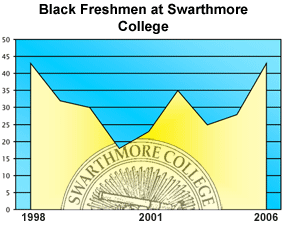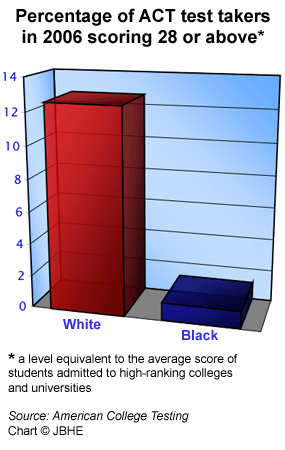United States Trails Most Other Developed Nations in Providing Higher Education Opportunities for Low-Income Students
 A new report from The Education Trust, a nonprofit research organization, has found that the United States ranks below most other developed countries in providing higher education for high-achieving low-income students. The report, Promise Abandoned: How Policy Choices and Institutional Practices Restrict College Opportunities, states that low-income students in this country are finding it increasingly difficult to afford college. Data presented in the report shows that only 78 percent of the highest-achieving students from the lowest-income groups go on to college. This is nearly identical to the college enrollment rate for the lowest-achieving students from upper-income families. A new report from The Education Trust, a nonprofit research organization, has found that the United States ranks below most other developed countries in providing higher education for high-achieving low-income students. The report, Promise Abandoned: How Policy Choices and Institutional Practices Restrict College Opportunities, states that low-income students in this country are finding it increasingly difficult to afford college. Data presented in the report shows that only 78 percent of the highest-achieving students from the lowest-income groups go on to college. This is nearly identical to the college enrollment rate for the lowest-achieving students from upper-income families.
The report criticizes colleges and universities for admission and financial aid practices which benefit middle- and upper-income students, leaving less financial aid money for those who really need it. The report also criticizes admissions procedures that offer no incentives for admissions officers to seek out and recruit high-achieving low-income students.
The Education Trust report can be downloaded by clicking here.
  |
“Higher education has become another agent of stratification. Our highest-achieving low-income students actually go directly on to college at rates about the same as our lowest-achieving students from wealthy families.”
— Kati Haycock, Promise Abandoned: How Policy Choices and Institutional Practices Restrict College Opportunities, The Education Trust, 2006 (See story below.)
|
The Roller-Coaster Ride of Black Enrollments at Swarthmore College Again Reaches a Pinnacle
In 1998 there were 43 black freshmen in the entering class at highly selective Swarthmore College. They made up 11.6 percent of all first-year students at Swarthmore that year. This was the highest percentage of blacks in an entering class of the nation’s 25 highest-ranked liberal arts colleges ever recorded by the annual JBHE survey on black freshman enrollments.
Just three years later in 2001, there were only 18 black freshmen at Swarthmore, a decline of 58 percent. The decline occurred at the time that Swarthmore dropped intercollegiate college football.
Now Swarthmore reports that once again there are 43 blacks in this year’s entering class. As was the case eight years ago, black students make up 11.6 percent of all freshmen at Swarthmore.

The Racial Digital Divide Narrows in Schools But Remains a Chasm in the Home
 A new report from the National Center for Education Statistics reveals that black and white children now have about equal access to computers in the classroom. But significant racial disparities remain in students’ computer use at home as well as in overall access to the Internet. This persisting racial digital divide in the home makes it more difficult for black students to satisfactorily complete high school and prepare for college. A new report from the National Center for Education Statistics reveals that black and white children now have about equal access to computers in the classroom. But significant racial disparities remain in students’ computer use at home as well as in overall access to the Internet. This persisting racial digital divide in the home makes it more difficult for black students to satisfactorily complete high school and prepare for college.
Here is the latest data:
Eighty-six percent of black children in grades K-12 use computers. For whites, the figure is slightly higher at 93 percent. The computer gap is almost nonexistent in schools with blacks and whites using computers at nearly the same rate. But there is still a large gap in computer usage in the home. The data shows that 78 percent of white schoolchildren use a computer at home compared to only 46 percent of black children.
A second digital divide has developed in Internet use. The study found that 67 percent of white schoolchildren use the Internet either at home or in school. But only 47 percent of blacks in grades K-12 use the Internet. Only 27 percent of blacks in grades K-12 use the Internet at home compared to 54 percent of whites.
Black Admissions Up, But Black Enrollments Down at the University of South Florida
The following headlines appeared four days apart in the Tampa Tribune and the St. Petersburg Times:
Push for Diversity Yields Results at the University of South Florida
University of South Florida Gets Fewer Blacks in Classes
 Why the discrepancy? The Tampa Tribune was reporting on admissions figures released by the University of South Florida in Tampa. Those figures showed that 1,300 black freshmen were admitted this year, an increase of 23 percent from a year ago. This was a significant improvement considering the university had toughened admissions standards which resulted in an overall acceptance rate of 51 percent of all applicants, down from 58 percent a year ago. Remember, too, that state-operated colleges and universities in Florida are prohibited from using race as a factor in their admissions decisions. Why the discrepancy? The Tampa Tribune was reporting on admissions figures released by the University of South Florida in Tampa. Those figures showed that 1,300 black freshmen were admitted this year, an increase of 23 percent from a year ago. This was a significant improvement considering the university had toughened admissions standards which resulted in an overall acceptance rate of 51 percent of all applicants, down from 58 percent a year ago. Remember, too, that state-operated colleges and universities in Florida are prohibited from using race as a factor in their admissions decisions.
Four days later the St. Petersburg Times’ headline reflected the development that many of the black students accepted at the University of South Florida decided not to enroll. Only 301 of the 1,300 blacks admitted to the university actually enrolled. This is down 12 percent from a year ago. In 2005 black enrollments were down 19 percent from 2004 levels.
Thus, while the university was successful in boosting the number of black applicants, it continues to experience a serious problem in convincing accepted black students to enroll. University officials believe that many of the state’s most qualified black students are choosing to attend private colleges and universities outside of Florida where financial aid may be more plentiful.There was some good news to report. University officials report that black enrollments at the graduate level are up 42 percent from a year ago. Overall, blacks make up 11.3 percent of the student body at the University of South Florida.

The University of North Carolina at Charlotte

Department of Communication Studies seeks to fill a tenure-track position in Organizational Communication at the rank of Assistant or Associate Professor.
Review process will begin October 15, 2006 and continue until filled. Position begins August 2007.
Ph.D. or appropriate terminal degree required. The department especially seeks candidates with a background in one or more of the following areas of organizational communication research: globalization, distributed work, multinational organizations, temporality, technology, and quantitative methods. Conduct research, teach, and advise B.A. and M.A. students in the Department of Communication Studies as well as the University¹s new interdisciplinary Ph.D. program in Organizational Science, which includes faculty in organizational communication, management, industrial psychology, and organizational sociology. Candidates are expected to maintain a strong record of research and professional activity consistent with Ph.D.-granting academic programs.
As one of the Southeast's premier places to live, more than 500,000 people reside within Charlotte's borders, approximately 1.3 million within the metro area, and 6 million within a 100-mile radius. Charlotte is home to 292 of the top Fortune 500 companies and more than 340 foreign firms. Financial experts know Charlotte as the nation's second largest banking center.
Forward a cover letter, current vita, graduate transcript and have three original letters of reference sent to Dr. Richard Leeman, chair, Department of Communication Studies; 9201 University City Blvd.; Charlotte, NC. 28223-9201.
UNC Charlotte is an equal opportunity employer committed to building a culturally diverse intellectual community and strongly encourages women and minorities to apply. AA/EOE

Black Journalism Students Start Up New Magazine at the University of Florida

Many black students at the University of Florida have boycotted the weekly student newspaper, the Florida Alligator, because of a controversial cartoon depicting Condoleezza Rice and Kanye West. As a result, a new magazine will be launched this coming January at the University of Florida. Blacklisted, founded by a group of African-American journalism students at the university, will publish five times each academic year.
Editorial features will target all minority groups at the university. Advertisers will be sought to fund the new venture.
Black Students at a South African University Go On Strike
 Black students at the University of Limpopo in northeastern South Africa called a strike claiming that they have been unfairly treated by the university’s administration. A spokesman for the Pan Africanist Student Movement of Azania claims that white students at the university were housed in residence halls that were far superior than the accommodations offered to black students. He claimed that the residence halls in which many black students are housed are dilapidated and in need of major repairs. Black students at the University of Limpopo in northeastern South Africa called a strike claiming that they have been unfairly treated by the university’s administration. A spokesman for the Pan Africanist Student Movement of Azania claims that white students at the university were housed in residence halls that were far superior than the accommodations offered to black students. He claimed that the residence halls in which many black students are housed are dilapidated and in need of major repairs.
The student group also said they were angered by recent fee increases at the university.
After Racial Gaffe, Senator George Allen Declines an Award From the Thurgood Marshall Scholarship Fund
 The Thurgood Marshall Scholarship Fund, a nonprofit group representing 47 state-operated historically black colleges and universities, planned to honor GOP Senator George Allen with its 2006 Community Leadership Award recognizing the legislator’s support for historically black colleges and universities. The Thurgood Marshall Scholarship Fund, a nonprofit group representing 47 state-operated historically black colleges and universities, planned to honor GOP Senator George Allen with its 2006 Community Leadership Award recognizing the legislator’s support for historically black colleges and universities.
But then Senator Allen referred to a campaign aide of his opponent for the Virginia U.S. Senate seat as “Macaca.” The term refers to a particular genus of monkey. The campaign aide who Senator Allen was referring to is of Indian descent.
Allen voluntarily decided not to accept the honor when it was revealed that several potential donors to the Thurgood Marshall Scholarship Fund threatened to withhold money from the organization if Allen was given the award.
Appointments
 • Eleanor Gwynn, professor of dance at North Carolina A&T State University in Greensboro, was appointed chair of the department of visual and performing arts at the university. Professor Gwynn holds a doctorate in dance from the University of Wisconsin. • Eleanor Gwynn, professor of dance at North Carolina A&T State University in Greensboro, was appointed chair of the department of visual and performing arts at the university. Professor Gwynn holds a doctorate in dance from the University of Wisconsin.
 • Diane R. Brown was named interim director of alumni development for the College of Engineering at North Carolina A&T State University. An alumna of A&T, she earned an MBA from Clark Atlanta University. • Diane R. Brown was named interim director of alumni development for the College of Engineering at North Carolina A&T State University. An alumna of A&T, she earned an MBA from Clark Atlanta University.
 • Cheryl Bailey Gittens was named director of the Ronald E. McNair Post-Baccalaureate Achievement Program at Virginia Tech. She was an assistant professor and director of the Health Careers Opportunity Program at the Annandale campus of Northern Virginia Community College. • Cheryl Bailey Gittens was named director of the Ronald E. McNair Post-Baccalaureate Achievement Program at Virginia Tech. She was an assistant professor and director of the Health Careers Opportunity Program at the Annandale campus of Northern Virginia Community College.
Gittens holds a bachelor’s and master’s degree from Rutgers University and is currently a doctoral candidate in higher education administration from George Washington University.
 • Leslie T. Fenwick was appointed dean of the Howard University School of Education. Dr. Fenwick was a professor of education policy and associate dean of the School of Education at Clark Atlanta University. A graduate of the University of Virginia, Dean Fenwick holds a master’s degree from the University of Toledo and a doctorate in educational policy and leadership from Ohio State University. • Leslie T. Fenwick was appointed dean of the Howard University School of Education. Dr. Fenwick was a professor of education policy and associate dean of the School of Education at Clark Atlanta University. A graduate of the University of Virginia, Dean Fenwick holds a master’s degree from the University of Toledo and a doctorate in educational policy and leadership from Ohio State University.
|
Study Finds That Simple Exercises Designed to Improve Self-Esteem Can Reduce the Black-White Achievement Gap
A remarkable new study authored by Geoffrey Cohen, an associate professor of psychology at the University of Colorado, and Julio Garcia, an associate research scientist at Yale University, finds that a simple academic exercise in boosting self-esteem can significantly reduce the academic achievement gap between blacks and whites.
The study, published in the highly regarded journal Science, reports that when African-American students were given an in-class writing assignment designed to boost their self-esteem at the start of the school year, their grades improved by three tenths of a point on a four-point grade scale. White students who were given the assignment did not show any improvement in their grades.

A control group of African-American students was given a different assignment that did not seek to reaffirm the students’ self-esteem. This group showed no improvement in closing the racial gap.
 The authors refer to research by Stanford psychologist Claude Steele and others which contends that African-American students are subjected to high levels of stress in the classroom stemming from negative stereotypes that depict them as intellectually inferior to whites. This stress, in turn, leads to academic underperformance which supports the stereotype. The authors refer to research by Stanford psychologist Claude Steele and others which contends that African-American students are subjected to high levels of stress in the classroom stemming from negative stereotypes that depict them as intellectually inferior to whites. This stress, in turn, leads to academic underperformance which supports the stereotype.
The authors believe so-called self-affirmation exercises used on a larger scale could result in a lowering of the racial achievement gap.
Whites Replacing Blacks as Teachers in New York City Public Schools
 It is widely believed that African-American schoolchildren are more likely to succeed in preparing for college if they have a large number of African-American teachers as role models in high school. Black teachers, too, may be less likely to succumb to the stereotype of low expectations for black students. It is widely believed that African-American schoolchildren are more likely to succeed in preparing for college if they have a large number of African-American teachers as role models in high school. Black teachers, too, may be less likely to succumb to the stereotype of low expectations for black students.
But for black students in the school system of the nation’s largest city, the number of new black teachers is half of what was the case just five years ago. The New York City Department of Education reports that in 2001 blacks made up 27.2 percent of the 8,000 new teachers hired by the city. For the current academic year, blacks made up only 14 percent of all new teachers hired for the public school system.
White teachers are taking the place of blacks. In 2001 whites were 54 percent of the new teaching hires. In 2006 whites made up 68 percent of the new teachers.
  |
11.3% Percentage of all non-Hispanic white people in the United States in 2005 who were not covered by health insurance.
19.6% Percentage of all African Americans in the United States in 2005 who were not covered by health insurance.
source: U.S. Bureau of the Census
|
Almost No Blacks at the Top of the ACT Scoring Pyramid
 For students who take the ACT college admissions test, the nation’s highest-ranked colleges and universities aim to recruit students who score 28 or above. (The ACT test is scored on a scale of 1 to 36.) For students who take the ACT college admissions test, the nation’s highest-ranked colleges and universities aim to recruit students who score 28 or above. (The ACT test is scored on a scale of 1 to 36.)
Nationwide in 2006, only 1,544 black students scored 28 or above on the ACT test. They made up 1.1 percent of all black ACT test takers. In contrast, 95,391 white students scored 28 or above on the ACT test this year. They made up 12.6 percent of all white ACT test takers. Thus, whites were more than 11 times as likely as blacks to score at a level equal to the mean score of students admitted to the nation’s most prestigious colleges and universities.
These scores demonstrate that in strict race-neutral admissions environments — such as the ones that still prevail at state universities in California, Florida, and Washington State — very few black students will score high enough on standardized admissions tests to qualify for places at the nation’s highest-ranked public universities. The ACT test is the most widely used college entrance examination in the state of Michigan. This November, voters in Michigan will decide whether to abolish race-sensitive admissions programs at the University of Michigan and other state-run universities. If voters take this step, the small number of blacks scoring at the top of the ACT scoring pyramid will result in a huge reduction in black students at the University of Michigan.
There is an even higher racial scoring gap at the very top of the ACT scoring pyramid. Of the 139,000 blacks who took the ACT test this year, not one of these students had a perfect score of 36. On the other hand, there were 143 white students who received the top score of 36. Five black students achieved a score of 35 on the ACT. There were 1,215 white students who scored 35 on the ACT.
But here are the most discouraging statistics in the current year’s ACT report: In 2006, 89 percent of all white test takers scored at or above the median level for blacks. Only 12 percent of all black ACT test takers scored at or above the median level for whites.

Mayor Proposes to Name the Train Station in Macon, Georgia, in Honor of a Black Scholar of the Classics
 C. Jack Ellis, the current mayor of Macon, Georgia, and the first African American to serve in the post, has proposed that the city’s Terminal Station be named in honor of the black scholar William Sanders Scarborough. A Macon native, Scarborough was born a slave. After studying at Atlanta University he earned bachelor’s and master’s degrees at Oberlin College. His 1881 Greek textbook, believed to be the first book authored by an African American in the Greek language, drew national attention. He was a member of the American Philological Association for 44 years. C. Jack Ellis, the current mayor of Macon, Georgia, and the first African American to serve in the post, has proposed that the city’s Terminal Station be named in honor of the black scholar William Sanders Scarborough. A Macon native, Scarborough was born a slave. After studying at Atlanta University he earned bachelor’s and master’s degrees at Oberlin College. His 1881 Greek textbook, believed to be the first book authored by an African American in the Greek language, drew national attention. He was a member of the American Philological Association for 44 years.  In 1884 he became the first black member of the Modern Language Association. Scarborough served as president of Wilberforce University from 1908 to 1920. In 1884 he became the first black member of the Modern Language Association. Scarborough served as president of Wilberforce University from 1908 to 1920.
The station building, which no longer serves rail passengers, is being renovated by the city and will be used for offices and possibly to house a bus terminal. It is hoped that a new commuter rail service to Atlanta will be based at the station.
University of Arkansas Mounts $300,000 Advertising Campaign to Attract More Blacks to Campus
 The flagship campus of the University of Arkansas at Fayetteville is located in the northwestern corner of the state far from Arkansas’ black population centers. As a result, in a state where blacks make up 15 percent of the total population, only 5.5 percent of the undergraduate students enrolled at the university are black. The flagship campus of the University of Arkansas at Fayetteville is located in the northwestern corner of the state far from Arkansas’ black population centers. As a result, in a state where blacks make up 15 percent of the total population, only 5.5 percent of the undergraduate students enrolled at the university are black.
The university administration has launched a $300,000 media blitz in an effort to encourage more black students to apply to the Fayetteville campus. The university is running television, radio, and print advertisements targeting black students. In addition, the university is conducting workshops for high school students in predominantly black neighborhoods to help them prepare for the ACT test and to educate them about the advantages of attending the Fayetteville campus.
68 Years After His Disappearance, Lloyd Gaines Earns the Right to Practice Law in the State of Missouri
 In 1935 Lloyd Gaines received a bachelor’s degree from Lincoln University, the historically black educational institution in Jefferson City, Missouri. He graduated with honors in history and was elected president of his class. Gaines then set his mind on law school. Missouri and its state university chose to send blacks seeking legal training to a number of other states. But Gaines demanded to be educated in his home state, and specifically at the University of Missouri Law School in Columbia. He applied for admission in 1936. His application was promptly rejected. In 1935 Lloyd Gaines received a bachelor’s degree from Lincoln University, the historically black educational institution in Jefferson City, Missouri. He graduated with honors in history and was elected president of his class. Gaines then set his mind on law school. Missouri and its state university chose to send blacks seeking legal training to a number of other states. But Gaines demanded to be educated in his home state, and specifically at the University of Missouri Law School in Columbia. He applied for admission in 1936. His application was promptly rejected.
After a long legal battle, The U.S. Supreme Court rendered its 6-2 verdict in favor of Gaines and ordered that either the University of Missouri Law School admit Gaines, or, alternatively, the state could build a law school for blacks of equal standing to the University of Missouri.
Missouri established a law school in St. Louis for blacks on a shoestring budget. Gaines and his lawyers prepared to challenge the legality of the so-called separate but equal law school. But when the day came for Gaines to file his deposition before the Supreme Court in October 1939, he disappeared without a trace. To this day, no one has ever discovered what happened to Lloyd Gaines. The last person to set eyes on the law student was a housekeeper who told police that Gaines stepped out to buy some stamps and never returned. It would be another decade after Gaines’ disappearance before an African American was admitted to the University of Missouri School of Law.
Now the state supreme court of Missouri and the state bar association have decided to issue Lloyd Gaines a license to practice law in the state. This spring Gaines received an honorary law degree from the University of Missouri law school.
Former Texas Southern University President Priscilla Slade Was Teaching Accounting But Now She Has Been Suspended
 Priscilla Slade, who earlier this year was dismissed from her position as president of Texas Southern University and later indicted on criminal charges of diverting public funds to remodel her home in Houston, was teaching a course this semester on accounting at the Jesse H. Jones School of Business at the university. Under university rules, Slade was entitled to 75 percent of her salary as an administrator. This made Slade the highest-paid faculty member on campus with a salary of more than $208,000. Priscilla Slade, who earlier this year was dismissed from her position as president of Texas Southern University and later indicted on criminal charges of diverting public funds to remodel her home in Houston, was teaching a course this semester on accounting at the Jesse H. Jones School of Business at the university. Under university rules, Slade was entitled to 75 percent of her salary as an administrator. This made Slade the highest-paid faculty member on campus with a salary of more than $208,000.
But when word of Slade’s teaching assignment reached the press, the university’s acting president Bobby Wilson suspended her from the classroom saying that she presented “an ongoing threat of disrupting the academic process.” Slade, who holds tenure, will go on paid leave. The university has now started the process to revoke her tenure.
Dr. Slade maintains her innocence and has filed a suit against the university for wrongful termination.
In Memoriam
John Etta Slaughter (1929-2006)
John Etta Slaughter, the longtime professor of history and former chair of the department of social sciences at St. Philip’s College in San Antonio, Texas, died late last month from breast cancer. She was 76 years old.
A native Texan, Slaughter earned her teacher’s certificate at Wiley College. She went on to earn a bachelor’s degree and a master’s degree in American history at Howard University. After working for the local school district in San Antonio, Slaughter spent 22 years on the faculty at St. Philip’s College before retiring in 1992.
|
 .
.